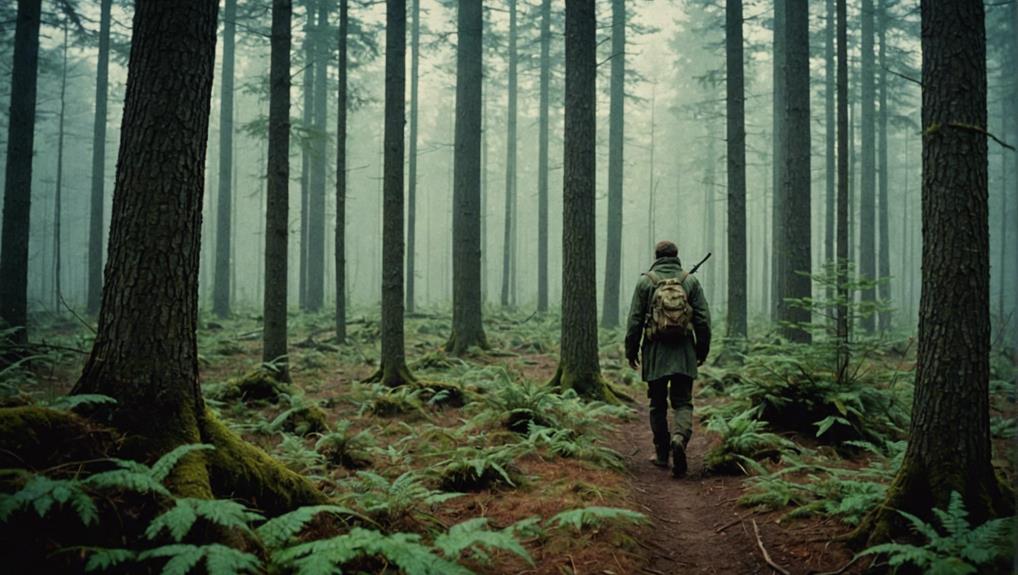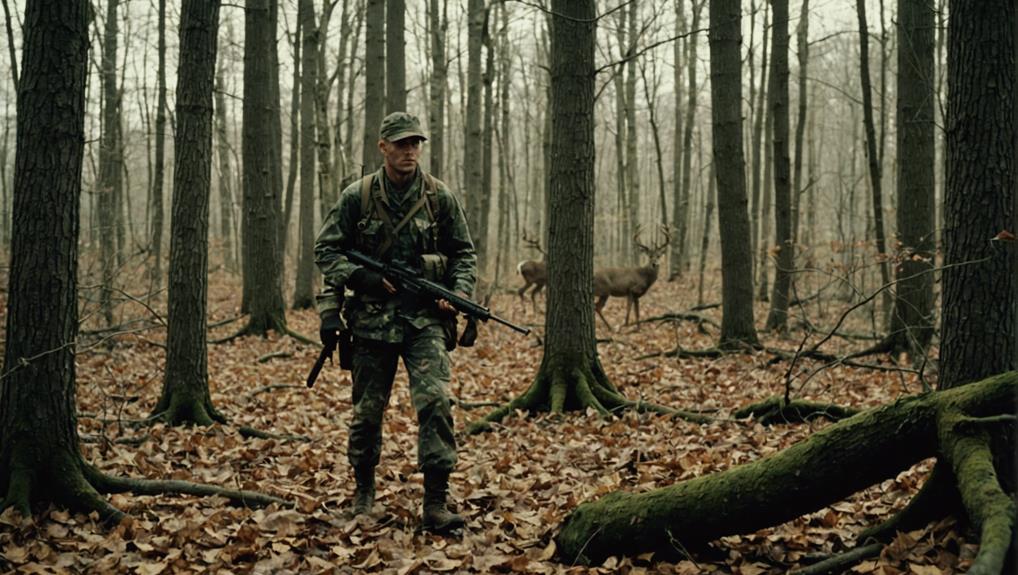Still hunting is the art of moving silently and deliberately through the wilderness, blending seamlessly with your surroundings to stalk game. This ancient practice, passed down through generations, calls for the patience of a medieval archer and the stealth of a shadow. You'll rely on camouflage, keen observation, and an intimate understanding of wildlife behavior. The rewards are immense: an unparalleled connection with nature and the thrill of outwitting wary prey. If you want to learn how this technique transforms you into part of the landscape, there's much more to uncover.
Key Takeaways
- Moving silently and blending into the natural surroundings to approach game animals.
- Employing patience and keen observation to track and spot game.
- Using camouflage clothing and scent control to remain undetected.
- Adapting strategies based on changing environmental conditions and animal behavior.
- Developing a deep understanding of the terrain and wildlife habits to increase success.
Definition of Still Hunting
Imagine creeping silently through dense woods, each step carefully placed to avoid snapping twigs or rustling leaves—this is the essence of still hunting. You move slowly, blending into the natural surroundings, harnessing a technique that demands both patience and stealth.
As you make your way from one cover to the next, your senses are heightened, tuned to the subtle signs of a game animal nearby. This isn't just hunting; it's a dance with nature, where each move is calculated to bring you closer to your quarry without alerting it to your presence.
In still hunting, your awareness of the environment and the behavior of the game animal is paramount. You study the terrain, understand animal tracks, and anticipate their movements. The technique involves a deliberate, almost meditative pace, where you stop often to observe and listen.
This method isn't for the impatient; it's a challenging pursuit that rewards those who embrace the slow, deliberate approach. For centuries, hunters have relied on this demanding yet fulfilling technique to stalk big game animals. It's a practice that connects you deeply with the wild, offering a sense of freedom and accomplishment that few other experiences can match.
History and Origins
As you master the art of still hunting, it's fascinating to realize that this stealthy dance with nature has roots that stretch back to our earliest ancestors. Long before modern conveniences, early humans relied on this hunting practice known for its patience and precision. They moved silently through forests and fields, using the natural terrain to blend seamlessly into their surroundings.
The technique where a safe approach is paramount is more than just a method; it's a tribute to human ingenuity and adaptability. Imagine ancient hunters, clad in animal skins, creeping through dense foliage, their senses finely tuned to the slightest movement or sound. This primal connection to the land and its creatures has persisted through the ages, evolving yet remaining true to its origins.
- Ancient techniques: Early humans used still hunting to survive, honing their skills for food and safety.
- Cultural significance: Many indigenous cultures passed down this practice through generations.
- Modern adaptation: Contemporary hunters continue to refine this method, blending tradition with new strategies.
In contrast to the noisy, high-energy Man Drive hunts, still hunting offers a serene, almost meditative experience. Embrace this ancient technique, and you'll find a deeper connection to the wilderness and a sense of freedom that's truly timeless.
Techniques and Strategies
Mastering the techniques and strategies of still hunting transforms you into a silent predator, weaving through the wilderness with the precision of our ancient forebears. Imagine yourself moving with deliberate, slow steps, each one calculated to avoid snapping twigs or rustling leaves. This isn't just hunting; it's a dance with nature, where your every movement must be as quiet as a whisper.
Still hunting demands you to seek cover, blending seamlessly with the environment. You become one with the trees, the brush, and the shadows. Patience is your greatest ally as you keenly observe your surroundings, watching for the slightest sign of game animals. It's an art of being present, where the world narrows to the rustle of a branch or the distant call of a bird.
Adaptability is essential. Conditions change, and so must you. A sudden shift in the wind, a change in light—each demands a recalibration of your approach. By minimizing noise and movement, you close the distance to your quarry, whether in dense woods or open landscapes.
Embrace the freedom that comes with still hunting. It's a timeless practice, empowering you to connect deeply with the wild, just as our ancestors once did.
Essential Gear
To master the art of still hunting, you'll need essential gear that echoes the stealth of hunters from centuries past. Camouflage and clothing blend you seamlessly into the environment, while your weapon of choice must be both reliable and precise.
Don't overlook scent control products; they're vital for remaining undetected by your quarry's keen sense of smell.
Camouflage and Clothing
Dressed in carefully chosen camouflage, you become a silent shadow in the wilderness, merging seamlessly with the trees and underbrush to outsmart your quarry. This art form, perfected by indigenous hunters and early frontiersmen, hinges on your ability to blend into surroundings using natural cover. Your success in still hunting depends on how well you can disappear into the landscape.
To achieve this, consider the following essential elements of camouflage clothing:
- Color and pattern: Choose gear that mimics the natural hues and textures of the environment you're hunting in.
- Fit and material: Opt for clothing that allows silent movement; avoid materials that rustle.
- Layers: Wear multiple layers to adapt to changing weather and maintain comfort without compromising camouflage.
With the right camouflage clothing, you use natural cover like trees, bushes, and rocks to conceal your movements.
The thrill of still hunting lies in the freedom it offers—the autonomy to move slowly, scan the environment, and adjust your approach. Remember, you're not just hunting; you're becoming part of the wilderness, a timeless dance that connects you to the primal essence of the hunt.
Weapon of Choice
A reliable weapon, steeped in history and honed by countless hunters, is your indispensable ally in the art of still hunting. Imagine yourself moving stealthily through the woods, your keen senses alert, every rustle of leaves sending a thrill through your veins. To succeed in still hunting, your weapon of choice must blend power and precision, allowing you to seize the perfect moment.
Rifles, revered for their accuracy and range, are a popular choice among still hunters. The bolt-action rifle, with its storied past in both military and hunting contexts, offers unparalleled accuracy. On the other hand, the lever-action rifle, with its rapid-fire capability, provides a nostalgic nod to the days of the Wild West, embodying the spirit of freedom and adventure.
For those who seek the primal challenge, a traditional bow or modern compound bow can turn the hunt into an art form. With a bow, you must get even closer to your quarry, demanding heightened stealth and patience.
Every hunter knows that their weapon of choice defines their experience. Whether you wield a rifle or a bow, the bond between hunter and weapon is essential.
Embrace your weapon, and let it become an extension of your will and skill in the timeless tradition of still hunting.
Scent Control Products
When you're out in the wild, the subtle art of scent control can mean the distinction between a successful hunt and a missed opportunity. Scent control products are your secret weapon to reduce your scent profile and move undetected by game animals. These tools have evolved from ancient hunters masking their scent with mud and leaves to today's advanced technologies.
Modern scent control products include:
- Scent-eliminating sprays: Perfect for neutralizing odors on your gear and clothing.
- Scent-free soaps and shampoos: Essential for cleansing yourself without leaving a trace.
- Scent-free clothing and scent-blocking technology: Designed to lock in human scent and keep you invisible to your prey.
Imagine slipping through the forest, just like the Native American hunters who moved with the wind to stay undetected. With these products, you're not only reducing your scent profile; you're stepping into a tradition of stealth and skill that dates back centuries.
Incorporating these scent control products into your hunting gear will notably increase your hunting success. Picture getting closer to that wary deer or elusive elk without ever raising their alarm. For the freedom-loving hunter, mastering scent control is more than a tactic; it's a game changer.
Skills Required

To master still hunting, you'll need the patience of a medieval archer and the stealth of a shadow. Your ability to observe every rustle and whisper in the forest can mean the difference between success and going home empty-handed.
Embrace the art of moving deliberately, blending with the landscape like a seasoned tracker from centuries past.
Patience and Stealth
Often, the success of still hunting hinges on your ability to blend into the landscape, moving with the deliberate stealth of a Native American tracker. This ancient practice demands a mastery of patience, stealth, and observation, as you become one with nature, carefully traversing the woods and fields.
Imagine the forest as your sanctuary, where every step is calculated, and every sound is a whisper. To become a successful still hunter, you must embrace:
- Patience: Master the art of waiting, knowing that haste can ruin your chances.
- Stealth: Move silently, utilizing natural cover and terrain to remain unseen.
- Observation: Maintain constant awareness of wind direction and noise levels to avoid detection.
This method isn't for the faint-hearted. It's a test of your will and perseverance, echoing the age-old traditions of those who hunted for survival.
Each rustling leaf, each snapping twig becomes a potential giveaway. But with keen senses and a calm mind, you can outwit even the most alert game.
Still hunting is more than a technique; it's a journey into the wild, offering a profound connection to the land and a sense of ultimate freedom.
Observational Techniques
As you master patience and stealth in still hunting, honing your observational techniques becomes paramount, transforming the forest into a living tapestry of clues and signals. Your observational skills will become your greatest ally, allowing you to decipher the subtle movements of game and the whispers of the wind through the leaves. Historical hunters, from Native American trackers to frontiersmen, relied on their acute senses to survive and thrive in the wild. Embrace their legacy by developing your game spotting abilities.
Imagine the thrill of noticing a slight rustle or a flash of movement that others might miss. It's about blending in so perfectly that nature reveals itself to you. Stealth and patience aren't just strategies; they're your passport to freedom in the wilderness. You'll start to recognize patterns, like the way deer move at dawn or the distinctive sound of a twig snapping under a predator's paw.
| Observation Skill | Description | Benefit |
|---|---|---|
| Visual Acuity | Spotting subtle movements | Early detection of game |
| Auditory Awareness | Identifying animal sounds | Anticipate game location |
| Situational Analysis | Reading environmental clues | Strategic positioning |
Hone these skills, and the forest will become your ally, guiding you to your quarry.
Benefits of Still Hunting
Mastering the art of still hunting offers hunters unparalleled intimacy with nature, allowing them to move like shadows and catch even the wariest game off guard. This practice, steeped in tradition, transforms the hunter into a part of the landscape, blending seamlessly with the environment to track animals like deer and elk. The deliberate, slow movements required mean you're not just hunting; you're becoming one with the wilderness.
Imagine the thrill of stalking silently through a dense forest, feeling every leaf crunch underfoot, watching for the faintest flicker of movement. You're not just an observer; you're a participant in an age-old dance between predator and prey.
The benefits of still hunting are multifaceted:
- Enhanced Patience: This practice hones your ability to wait and watch, developing a deeper sense of timing and patience.
- Stealth and Strategy: Moving quietly and using natural cover, you learn to outthink and outmaneuver even the most alert animals.
- Adaptability: As conditions change, you can adjust your approach, making strategic decisions to increase your chances of success.
Challenges Faced

Venturing into the domain of still hunting, you'll encounter numerous challenges that test both your physical endurance and mental acuity. Picture yourself moving slowly, almost imperceptibly, through the dense woods, each step deliberate and quiet. This isn't a group endeavor; it's a solitary communion with nature where you rely solely on your skills.
Your ability to read animal signs—tracks, scat, subtle movements—becomes your guiding light in this ancient practice. Still hunting best describes an approach that demands not just patience but a deep understanding of animal behavior and habitats. Historically, indigenous peoples and early settlers alike adopted this method, blending seamlessly into their surroundings to secure food.
Today, you must channel that same spirit, moving like a shadow among the trees. The physical challenges are undeniable. Hours of slow, controlled movements can be grueling, testing your stamina and focus. Mentally, you'll need to stay sharp, constantly scanning for signs and staying aware of wind direction and noise levels.
The thrill of not being detected by your quarry is matched only by the freedom you feel in mastering such a demanding, yet rewarding, skill. The art of still hunting isn't just a pursuit; it's a demonstration of human resilience and ingenuity.
Safety Tips
Exploring the wilderness with the stealth of a shadow, you must always prioritize safety to make sure your still hunting experience remains as rewarding as it's challenging. To embody the spirit of the frontiersmen known as a Man, a few key guidelines can keep you safe and secure while you navigate the wild.
First, always hunt in a group or at least inform someone of your location and expected time of return. This guarantees that if anything goes awry, help can be dispatched promptly.
- Wear high-visibility gear: While still hunting relies on concealment, safety can never be compromised. Bright colors can prevent accidental encounters with other hunters.
- Know your firearm: Understanding your weapon thoroughly is vital. Safety locks, proper handling, and regular maintenance can prevent accidents.
- Carry a communication device: A fully charged phone or a two-way radio ensures you can call for help if needed.
Patience and keen observation are your allies, but never let your focus on the prey distract you from the terrain and potential hazards. Adaptability, like the legendary hunters of yore, will keep you safe. Remember, the wilderness offers freedom, but only if you respect its inherent risks.
Frequently Asked Questions
What Best Describes the Practice of Still Hunting?
You'll master patience techniques, embrace silent movement, and perfect camouflage strategies. Like ancient hunters stalking prey, you blend into the wilderness, moving stealthily. This freedom-filled practice lets you connect deeply with nature and your primal instincts.
What Does "Still Hunting" Mean?
Imagine you're a shadow in the forest, embodying the stealth techniques of ancient hunters. Still hunting means using silent movement and keen wildlife observation to blend with nature, ensuring close encounters with your quarry.
Which of the Following Best Describes the Hunting Practice Known as Deer Drive?
The practice known as deer drive involves a group strategy where hunters use team coordination and safety measures to drive deer out of dense cover. This method, historically used for centuries, guarantees effective and thrilling hunting experiences.
Which of the Following Best Describes the Code of a Hunter?
You're guided by hunter ethics, respecting hunting laws and contributing to conservation efforts. Like early pioneers, you balance freedom with responsibility, ensuring wildlife thrives for future generations. Embrace this legacy, and hunt with honor and integrity.
Conclusion
In embracing the art of still hunting, you channel the spirit of ancient hunters, moving silently like a shadow through the wilderness. With each step, you become a part of nature's timeless ballet, where patience and skill yield the ultimate reward.
Equip yourself with knowledge and respect for the wild, and you'll find that still hunting isn't just a technique—it's a homage to our primal roots, a dance as old as time itself. So, step lightly and hunt wisely.





I think still hunting requires patience and skill, but I wonder if its truly effective or just a romanticized hunting tradition.
I think still hunting requires patience and skill. Its like a slow-motion game of cat and mouse in the wilderness!
I find it odd that the article didnt discuss the ethics of still hunting. Is it really fair to the animals? Also, shouldnt the history part include indigenous hunting practices too? Just saying…
Interesting read, but isnt still hunting just a glorified term for sitting around waiting for prey to come to you? A bit too passive for my taste, dont you think? What about the thrill of the chase?
Interesting read, but isnt still huntings essence more about patience than strategy? Whats your take, folks?
Interesting read! But can we really say that still huntings origins are completely tied to our survivalist ancestors?
Absolutely! Its instinctual, a primal connection to our survivalist roots. Denying it is ignoring evolution.
Isnt it intriguing how still hunting techniques have evolved over the years? Curious about everyones favorite strategy.
Interesting read, but isnt still hunting essentially just stalking prey without using traps or dogs? Seems quite straightforward to me.
Interesting read! But dont you think the article couldve delved deeper into the historical significance of still hunting?
Perhaps, but the writers focus was likely on the practice, not the history. Different strokes!